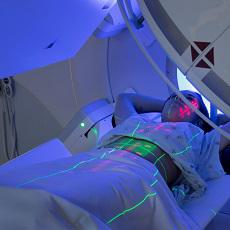
Radiation therapy is a cancer treatment. It uses high doses of radiation to kill cancer cells and stop them from spreading. About half of all cancer patients receive it. The radiation may be external, from special machines, or internal, from radioactive substances that a doctor places inside your body. The type of radiation therapy you receive depends on many factors, including:
- The type of cancer
- The size of the cancer
- The cancer's location in the body
- How close the cancer is to normal tissues that are sensitive to radiation
- How far into the body the radiation needs to travel
- Your general health and medical history
- Whether you will have other types of cancer treatment
- Other factors, such as your age and other medical conditions
Radiation therapy can damage normal cells as well as cancer cells. Treatment must be carefully planned to minimize side effects. Common side effects include skin changes and fatigue. Other side effects depend on the part of your body being treated.
- Radiation Therapy (National Library of Medicine)Radiation therapy is a cancer treatment. It uses high doses of radiation to kill cancer cells and stop ... doctor places inside your body. The type of radiation therapy you receive depends on many factors, including: The ...
- Radiation therapy uses high-powered radiation (such as x-rays or gamma rays), particles, or radioactive seeds to kill cancer cells.
- ... radiation is most harmful to quickly growing cells, radiation therapy damages cancer cells more easily than normal cells. ... Brachytherapy delivers radiation therapy directly to where cancer ... are located. It may involve placing a radioactive source into ...
- Whole breast radiation therapy uses high-powered x-rays to kill breast cancer cells. With this type of directed radiation therapy, the ...
- Partial breast radiation therapy uses high-powered x-rays to kill breast cancer cells. This type of treatment does not target the ...
- You are having radiation therapy . This is a type of treatment that uses high-powered x-rays or particles to kill cancer cells. You ...
- Stereotactic radiosurgery (SRS) is a form of radiation therapy that focuses high-power energy on a small area of the body. Despite its name, radiosurgery is a treatment, not a surgical procedure. ...
- ... is tissue swelling and irritation in the mouth. Radiation therapy or chemotherapy may cause mucositis. Follow your health ... takes 2 to 4 weeks. Mucositis caused by radiation therapy usually lasts 6 to 8 weeks, depending on ...
- Stereotactic radiosurgery (SRS) is a form of radiation therapy that focuses high-power energy on a small area of the body. Despite its name, radiosurgery is not actually a surgical procedure -- there ...
- You received stereotactic radiosurgery (SRS) or radiotherapy. This is a form of radiation therapy that focuses high-power x-rays onto a small area of your brain or spine. ...



